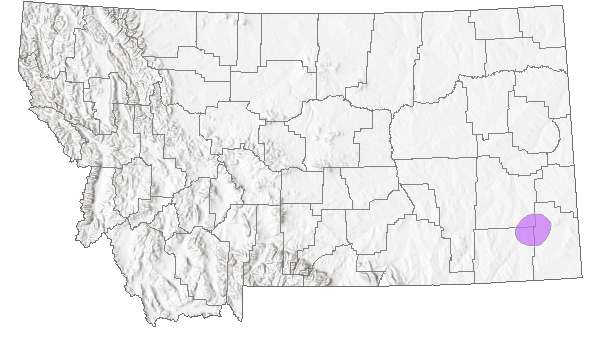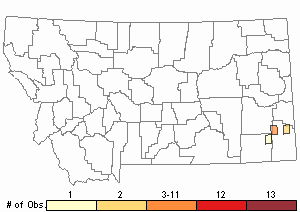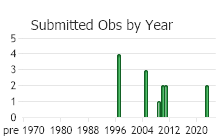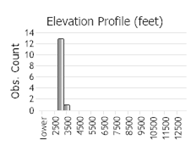View in other NatureServe Network Field Guides
NatureServe
Montana
Utah
Wyoming
Idaho
Wisconsin
British Columbia
South Carolina
Yukon
California
New York
Visher's Buckwheat - Eriogonum visheri
State Rank Reason (see State Rank above)
Eriogonum visheri is a regional endemic known in Montana since 1997 from only one area in Carter County. This population grows on sparsley vegetated alluvial outwash in badlands topography and as such does not appear to be threatened by weeds, livestock or other activities at this time.
- Details on Status Ranking and Review
Population Size
Score2-3 - Very Small to Small: Population size is imprecisely known but is believed to be <10,000 individuals.
Range Extent
Score2 - Regional or State Endemic or Small Montana Range: Generally restricted to an area <100,000 sq. miles (equivalent to 2/3 the size of Montana or less) or Montana contributes 50% or more of the species’ range or populations OR limited to 2-3 Sub-basins in Montana.
CommentRegional endemic of eastern Montana and the Dakotas.
Area of Occupancy
Score3 - Very Low: Generally occurring in 3 or fewer Subwatersheds (6th Code HUC’s).
Environmental Specificity
Score2 - High: Species is restricted to a highly specialized and limited habitat and is typically dependent upon unaltered, high-quality habitat (C Values of 8-10).
Trends
Score0-1 - Stable to Minor Declines:
CommentLikely stable with large annual fluctuations, though monitoring data are lacking.
Threats
Score0 - Low: Impacts, if any, to the species are expected to be minor or insignificant (affecting <10% of populations) in severity, scope and immediacy.
Intrinsic Vulnerability
Score1-2 - Moderate to High Vulnerability.
Raw Conservation Status Score
Score
10 to 14 total points scored out of a possible 19.
General Description
Eriogonum visheri is an erect, annual herb from a slender taproot and is widely brached resulting in a skeletal appearence. Several basal leaves are arranged in a rosette. Stem leaves are located on the lower portion of the stem and are more oblong and smaller than the basal leaves. Flowers are extremely small and pale yellow.
Phenology
Flowering occurs from late June to July.
Diagnostic Characteristics
There are only three other annual species of Eriogonum in Montana. Eriogonum cernuum and E. annuum have densely hairy foliage. Eriogonum salsuginosum has a deeply lobed cup-shaped involucre while that of E. visheri is shallowly lobed and top-shaped.
Species Range
Montana Range
Range Descriptions

 Native
Native
Range Comments
The only known populations of Eriogonum are located in the western Great Plains of North America, in western South Dakota, western North Dakota, and southeastern Montana. One population has been located in Montana (Carter county), 14 populations have been located in 7 counties in North Dakota (Billings, Golden Valley, Grant, McKenzie, Mountrail, Sioux, and Slope counties), and at least 79 populations have been located in 8 counties in South Dakota (Corson, Hardin, Jackson, Pennington, Perkins, Meade, Mellette, and Ziebach counties) (Vanderhorst et al. 1998, Lenz 1993, Ode 1987, Schmoller 1993).
Observations in Montana Natural Heritage Program Database
Number of Observations: 23
(Click on the following maps and charts to see full sized version)
Map Help and Descriptions
Relative Density

Recency



 (Observations spanning multiple months or years are excluded from time charts)
(Observations spanning multiple months or years are excluded from time charts)
Habitat
The entire range of the species lies within the unglaciated Missouri Plateau (Schmoller 1993), where it occurs on barren, sedimentary rock outcrops, the alluvium from those outcrops, and small exposures of soil substrates in badlands topography. It is most often found on the unvegetated clay outwash at the base of slopes, on the unvegetated eroding edge of tables, benches, terraces and buttes, and on more level patches of soil exposed by wind or water erosion. Typically, soils are low in organic matter, have a fine texture, high shrink-swell capacity, low infiltration rates, low soil moisture and low fertility. Soils are often strongly calcareous and high in sodium.
In Carter County, Eriogonum visheri grows on vesicular silt (derived from bentonite) in sparsely vegetated outwash flats below eroding bentonite badland slopes of the Hell Creek Formation. Bare ground often exceeds 90%, and there is minimal shading. Its habitat is dominated by Atriplex confertifolia and Artemisia tridentata, with a very high density of Musineon divaricatum and Allium textile. Other associates include Agropyron dasystachyum, Sitanion hystrix, Sarcobatus vermiculatus, Krascheninnikovia lanata, Oryzopsis hymenoides, Oenothera caespitosa and Atriplex suckleyi.
National Vegetation Classification System Groups Associated with this Species
Sparse and Barren
Sparse and Barren
Ecology
Visher's buckwheat grows in harsh and erosive environments where competition is limited and succession is slow (Schmoller 1993). The high erosion and deposition rates at these sites uproot or bury plants, and soils have a high shrink-swell potential that damages plant roots. Wind and water erosion, although limiting competition and succession, serve to disperse seeds and create suitable microhabitats for the species. Small mammals and passerine birds may collect and disperse the seeds (Vanderhorst et al. 1998; Ode 1987; Schmoller 1993).
This species is an annual, and thus subject to population fluctuations as well as shifts in topographic position, depending on patterns of dispersal and erosion. The plant's small size and sparsely vegetated habitat suggests that it is a poor competitor for light. The small size of the flowers suggest that it may be self-pollinated.
Plants of this species display a more vigorous, robust appearance when growing on soils with better horizonation, lower pH and higher organic matter content (Vanderhorst et al. 1998; Ode 1987; Schmoller 1993, 1995).
Management
High cattle stocking rates can negatively impact this species; however, cattle grazing is not common in its habitat since vegetation is sparse, and the plant does not appear to be favored by cattle (USDA 1988). When grazing does occur, it appears to be incidental or due to a paucity of forage. Light grazing on plants that compete with Visher's buckwheat may be beneficial. However, increased stocking to levels that cause range degradation would likely override any benefits to the species and may cause decline (Vanderhorst et al. 1998; Ode 1987; Schmoller 1993).
Trampling of Visher's buckwheat has been observed in South Dakota in areas where cattle move between forage areas (Schmoller 1993). However, its presence on cattle trails also suggests that trampling may disperse and help implant the seeds. Other types of ground surface disturbance are not necessarily detrimental to the species, and it has been observed to colonize areas disturbed by human activity, such as ditching for a pasture road (Schmoller 1993; Vanderpool 1993).
Exotic weeds have invaded this species' habitat in South Dakota; they include Salsola iberica and Kochia scoparia (Schmoller 1993). Other invasive weeds that may pose a similar threat are Bromus tectorum, B. japonicus, and Melilotus officinalis. Visher's buckwheat appears to be a poor competitor (Crowley 1998; Ode 1987; Vanderpool 1993), and thus may be particularly vulnerable to competition from weeds.
Stewardship Responsibility
Threats or Limiting Factors
STATE THREAT SCORE REASON
Threat impact not assigned because threats are not known (MTNHP Threat Assessment 2021).
References
- Literature Cited AboveLegend:
 View Online Publication
View Online Publication MTNHP Threat Assessment. 2021. State Threat Score Assignment and Assessment of Reported Threats from 2006 to 2021 for State-listed Vascular Plants. Botany Program, Montana Natural Heritage Program, Helena, Montana.
MTNHP Threat Assessment. 2021. State Threat Score Assignment and Assessment of Reported Threats from 2006 to 2021 for State-listed Vascular Plants. Botany Program, Montana Natural Heritage Program, Helena, Montana.
- Additional ReferencesLegend:
 View Online Publication
View Online Publication
Do you know of a citation we're missing? Heidel, B.L. and K.H. Dueholm. 1995. Sensitive plant survey in the Sioux District, Custer National Forest, 1994, Carter County, Montana and Harding County, South Dakota. Unpublished report to the Custer National Forest. Montana Natural Heritage Program, Helena, Montana. 95 pp. plus appendices.
Heidel, B.L. and K.H. Dueholm. 1995. Sensitive plant survey in the Sioux District, Custer National Forest, 1994, Carter County, Montana and Harding County, South Dakota. Unpublished report to the Custer National Forest. Montana Natural Heritage Program, Helena, Montana. 95 pp. plus appendices. Lesica, P., M.T. Lavin, and P.F. Stickney. 2012. Manual of Montana Vascular Plants. Fort Worth, TX: BRIT Press. viii + 771 p.
Lesica, P., M.T. Lavin, and P.F. Stickney. 2012. Manual of Montana Vascular Plants. Fort Worth, TX: BRIT Press. viii + 771 p. Lesica, P., M.T. Lavin, and P.F. Stickney. 2022. Manual of Montana Vascular Plants, Second Edition. Fort Worth, TX: BRIT Press. viii + 779 p.
Lesica, P., M.T. Lavin, and P.F. Stickney. 2022. Manual of Montana Vascular Plants, Second Edition. Fort Worth, TX: BRIT Press. viii + 779 p. North Dakota Natural Heritage Program. 1993. 1991-1992 inventory of rare plant species in the Little Missouri National Grasslands. Unpublished report to the Custer National Forest. Bismarck, North Dakota. 72 pp.
North Dakota Natural Heritage Program. 1993. 1991-1992 inventory of rare plant species in the Little Missouri National Grasslands. Unpublished report to the Custer National Forest. Bismarck, North Dakota. 72 pp. Ode, D.J. 1987. The status of Dakota wild buckwheat (Eriogonum visheri A. Nels.) in South Dakota. Report No. 87-8, Wildlife Division DS.D. Game, Fish and Parks Department, Pierre, South Dakota.
Ode, D.J. 1987. The status of Dakota wild buckwheat (Eriogonum visheri A. Nels.) in South Dakota. Report No. 87-8, Wildlife Division DS.D. Game, Fish and Parks Department, Pierre, South Dakota. Schmoller, David A. 1993. Status Survey for Eriogonum visheri. USDA Forest Service - Region 2, Nebraska National Forest, Wall, SD.
Schmoller, David A. 1993. Status Survey for Eriogonum visheri. USDA Forest Service - Region 2, Nebraska National Forest, Wall, SD. Schmoller, David A. 1995. Biological Evaluation of Eriogonum visheri Populations for 1995 Grazing Permit Reissuance. USDA Forest Service - Region 1, Custer National Forest, Ashland, MT.
Schmoller, David A. 1995. Biological Evaluation of Eriogonum visheri Populations for 1995 Grazing Permit Reissuance. USDA Forest Service - Region 1, Custer National Forest, Ashland, MT. USDA Forest Service. 1988. Range Plant Handbook. Dover Publications, Inc., New York, NY.
USDA Forest Service. 1988. Range Plant Handbook. Dover Publications, Inc., New York, NY. Vanderhorst, J.P., S.V. Cooper, and B.L. Heidel. 1998. Botanical and vegetation survey of Carter County, Montana. Unpublished report prepared for the Bureau of Land Management. Montana Natural Heritage Program, Helena. 116 pp. + app.
Vanderhorst, J.P., S.V. Cooper, and B.L. Heidel. 1998. Botanical and vegetation survey of Carter County, Montana. Unpublished report prepared for the Bureau of Land Management. Montana Natural Heritage Program, Helena. 116 pp. + app. Vanderpool, S.S. 1993. Distribution and occurrence of Eriogonum visheri A. Nels. on the Medora and McKenzie Districts, Little Missouri National Grasslands, in North Dakota. Unpublished report to the North Dakota Natural Heritage Program. Institute for Ecological Studies, University of North Dakota, Bismarck, North Dakota 28 pp.
Vanderpool, S.S. 1993. Distribution and occurrence of Eriogonum visheri A. Nels. on the Medora and McKenzie Districts, Little Missouri National Grasslands, in North Dakota. Unpublished report to the North Dakota Natural Heritage Program. Institute for Ecological Studies, University of North Dakota, Bismarck, North Dakota 28 pp.
- Web Search Engines for Articles on "Visher's Buckwheat"





